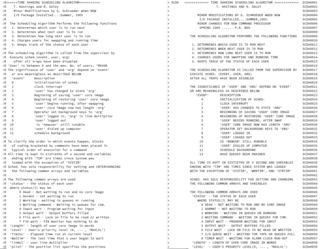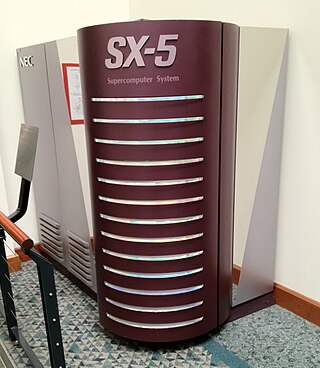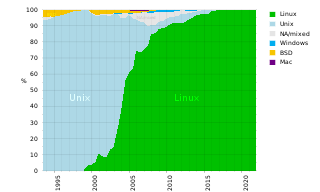
The Cray-1 was a supercomputer designed, manufactured and marketed by Cray Research. Announced in 1975, the first Cray-1 system was installed at Los Alamos National Laboratory in 1976. Eventually, eighty Cray-1s were sold, making it one of the most successful supercomputers in history. It is perhaps best known for its unique shape, a relatively small C-shaped cabinet with a ring of benches around the outside covering the power supplies and the cooling system.
UNICOS is a range of Unix and later Linux operating system (OS) variants developed by Cray for its supercomputers. UNICOS is the successor of the Cray Operating System (COS). It provides network clustering and source code compatibility layers for some other Unixes. UNICOS was originally introduced in 1985 with the Cray-2 system and later ported to other Cray models. The original UNICOS was based on UNIX System V Release 2, and had many Berkeley Software Distribution (BSD) features added to it.

Convex Computer Corporation was a company that developed, manufactured and marketed vector minisupercomputers and supercomputers for small-to-medium-sized businesses. Their later Exemplar series of parallel computing machines were based on the Hewlett-Packard (HP) PA-RISC microprocessors, and in 1995, HP bought the company. Exemplar machines were offered for sale by HP for some time, and Exemplar technology was used in HP's V-Class machines.

The IBM 7030, also known as Stretch, was IBM's first transistorized supercomputer. It was the fastest computer in the world from 1961 until the first CDC 6600 became operational in 1964.
Cray Inc., a subsidiary of Hewlett Packard Enterprise, is an American supercomputer manufacturer headquartered in Seattle, Washington. It also manufactures systems for data storage and analytics. Several Cray supercomputer systems are listed in the TOP500, which ranks the most powerful supercomputers in the world.
Parallel Virtual Machine (PVM) is a software tool for parallel networking of computers. It is designed to allow a network of heterogeneous Unix and/or Windows machines to be used as a single distributed parallel processor. Thus large computational problems can be solved more cost effectively by using the aggregate power and memory of many computers. The software is very portable; the source code, available free through netlib, has been compiled on everything from laptops to Crays.

The Compatible Time-Sharing System (CTSS) was the first general purpose time-sharing operating system. Compatible Time Sharing referred to time sharing which was compatible with batch processing; it could offer both time sharing and batch processing concurrently.
ETA Systems was a supercomputer company spun off from Control Data Corporation (CDC) in the early 1980s in order to regain a footing in the supercomputer business. They successfully delivered the ETA-10, but lost money continually while doing so. CDC management eventually gave up and folded the company.

The ETA10 is a vector supercomputer designed, manufactured, and marketed by ETA Systems, a spin-off division of Control Data Corporation (CDC). The ETA10 was an evolution of the CDC Cyber 205, which can trace its origins back to the CDC STAR-100, one of the first vector supercomputers to be developed.

The CDC STAR-100 is a vector supercomputer that was designed, manufactured, and marketed by Control Data Corporation (CDC). It was one of the first machines to use a vector processor to improve performance on appropriate scientific applications. It was also the first supercomputer to use integrated circuits and the first to be equipped with one million words of computer memory.

NEC SX describes a series of vector supercomputers designed, manufactured, and marketed by NEC. This computer series is notable for providing the first computer to exceed 1 gigaflop, as well as the fastest supercomputer in the world between 1992–1993, and 2002–2004. The current model, as of 2018, is the SX-Aurora TSUBASA.
The Network Livermore Timesharing System is an operating system that was actively developed at Lawrence Livermore Laboratory from 1979 until about 1988, though it continued to run production applications until 1995. An earlier system, the Livermore Time Sharing System had been developed over a decade earlier.

The National Energy Research Scientific Computing Center (NERSC), is a high-performance computing (supercomputer) National User Facility operated by Lawrence Berkeley National Laboratory for the United States Department of Energy Office of Science. As the mission computing center for the Office of Science, NERSC houses high performance computing and data systems used by 9,000 scientists at national laboratories and universities around the country. Research at NERSC is focused on fundamental and applied research in energy efficiency, storage, and generation; Earth systems science, and understanding of fundamental forces of nature and the universe. The largest research areas are in High Energy Physics, Materials Science, Chemical Sciences, Climate and Environmental Sciences, Nuclear Physics, and Fusion Energy research. NERSC's newest and largest supercomputer is Perlmutter, which debuted in 2021 ranked 5th on the TOP500 list of world's fastest supercomputers.
The ROSE compiler framework, developed at Lawrence Livermore National Laboratory (LLNL), is an open-source software compiler infrastructure to generate source-to-source analyzers and translators for multiple source languages including C, C++, Fortran, OpenMP, Java, Python, and PHP.

Unix is a family of multitasking, multi-user computer operating systems that derive from the original AT&T Unix, whose development started in 1969 at the Bell Labs research center by Ken Thompson, Dennis Ritchie, and others.
PathScale Inc. was a company that developed a highly optimizing C, C++, and Fortran compiler suite for the x86-64 microprocessor architectures. It derives from the SGI compilers for the MIPS architecture R10000 processor, called MIPSPro.
Harry Lewis Nelson was an American mathematician and computer programmer. He was a member of the team that won the World Computer Chess Championship in 1983 and 1986, and was a co-discoverer of the 27th Mersenne prime in 1979. He also served as editor of the Journal of Recreational Mathematics for five years. Most of his professional career was spent at Lawrence Livermore National Laboratory where he worked with some of the earliest supercomputers. He was particularly noted as one of the world's foremost experts in writing optimized assembly language routines for the Cray-1 and Cray X-MP computers. Nelson had a lifelong interest in puzzles of all types, and founded the MiniMax Game Company, a small venture that helps puzzle inventors to develop and market their products.
The Livermore Time Sharing System (LTSS) was a supercomputer operating system originally developed by the Lawrence Livermore Laboratories for the Control Data Corporation 6600 and 7600 series of supercomputers in 1965.

A supercomputer operating system is an operating system intended for supercomputers. Since the end of the 20th century, supercomputer operating systems have undergone major transformations, as fundamental changes have occurred in supercomputer architecture. While early operating systems were custom tailored to each supercomputer to gain speed, the trend has been moving away from in-house operating systems and toward some form of Linux, with it running all the supercomputers on the TOP500 list in November 2017. In 2021, top 10 computers run for instance Red Hat Enterprise Linux (RHEL), or some variant of it or other Linux distribution e.g. Ubuntu.









